Entries tagged with “Langhe”.
Did you find what you wanted?
Mon 28 Feb 2011
Last year I was lucky enough to enjoy a sneak preview of the new Barolo wine museum. Recently I visited it again, after the official opening, and I was really impressed.
The visitor is initially taken to the third floor of the castle and the visit is structured like a descent into the depths of wine culture: the atmospheric concept of venturing into the myths and mysteries of Bacchus’ nectar is matched by the physical sensation of going down into the heart of the Falletti castle, as the route descends from the third floor to the basement.
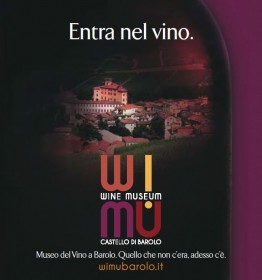 But the museum is not focused on the history and details of making Barolo. It seems like the main goal is to get visitors involved and engaged, and less to inform them. There is little factual information here and visitors looking to get an in-depth knowledge of winemaking are likely to be disappointed.
But the museum is not focused on the history and details of making Barolo. It seems like the main goal is to get visitors involved and engaged, and less to inform them. There is little factual information here and visitors looking to get an in-depth knowledge of winemaking are likely to be disappointed.
The main idea behind this wine museum is that nowadays wine tourists want more from their wine: in their search for high quality, they are interested in wine history, learning about production techniques, and understanding the characteristics of the area in question.
Music accompanies visitors as they walk through 25 rooms of the museum, from Antonio Vivaldi’s Four Seasons to modern songs celebrating wine to which a special room is dedicated.
In another room, with leather club chairs, velvet curtains and movie posters on the walls, clips are running of films inspired by wine, such as “Sideways”, “Blood and Wine” and “A Good Year”.
At the end of the journey, down in the basement, there is a wine shop which displays rows of old dusty bottles and where visitors can finally taste barolo’s warm flavor and buy some of the best labels, from Vietti to Bruno Giacosa, from Sandrone to Gaja to Giacomo Conterno.
If you stay with us this year, the museum is only 5 minutes walk from TorreBarolo and we took many pictures. You can see them in TorreBarolo Flickr account.
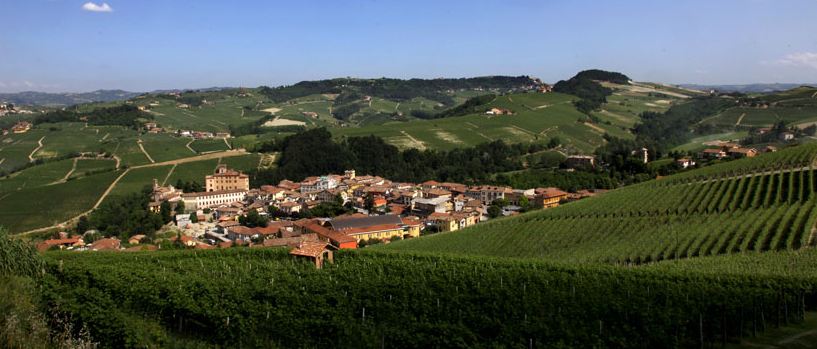
Thu 20 Jan 2011
How? Simply Like TorreBarolo on Facebook by the 15th of March, suggest our page to your friends (we do check that  and you automatically will qualify for the drawing.
and you automatically will qualify for the drawing.
If you have “liked” TorreBarolo already, then easy, just continue to support the TorreBarolo business page with your comments and suggest it to as many friends as possible (and we will check that, yes 
The rules: 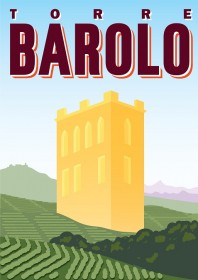
- As of March 15th, all names on our business page will be entered into a hat and we will draw a name. If the lucky winner is unable to redeem their prize, then we will draw a 2nd winner … and so on.
- The prize of 3 nights at TorreBarolo has a value of €375 and is not redeemable in cash. As is standard at TorreBarolo, a security deposit will still be requested upon check-in.
- The availability period for the winner’s 3 night stay runs from March 16th, 2011 to April 15th, 2011.
- If the winner removes him/herself from the TorreBarolo business page before their 3 night stay, the winner forfeits their winning.
- After staying at TorreBarolo, the winner will be requested to enter a review on the TorreBarolo website.
- The winner will be contacted via Facebook directly via their message inbox.
- The final winner will be announced on the business page on March 16th.
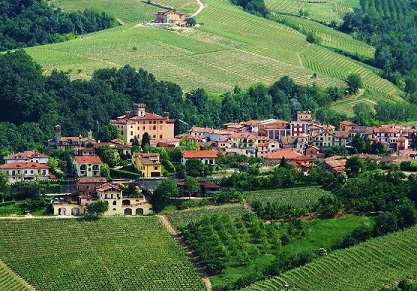
Fri 30 Jul 2010
When you need a break from eating and drinking all the wonderful Langhe cuisine, here is a suggestion for a few mini-excursion; go visit one of the well restored castles in Cuneo province.
My castle top picks in the Cuneo region are: Castello Roccolo di Busca, Castello Reale di Carlo Felice di Govone and Castello Reale di Racconigi.
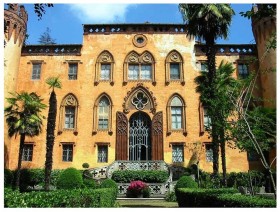
Castello Roccolo di Busca is located a bit over 30min by car from TorreBarolo and transports one from the rolling vine covered hills of the Langhe to the fruit orchards of the Cuneo valley, the region’s capital.
The castle is named after the nets used to catch small birds called “roccoli”. The castle has quite an impressive past having hosted such famous and noble individuals as the famous Italian writer, Silvio Pellico, King Umberto I and Queen Margherita. What I enjoy about the castle is it the neo-Gothic style, which was the fashion around Saluzzo in the mid 1800’s as well as favoured by the Savoy court. The exterior of the castle combines Moorish arches, rose windows and many floral features. 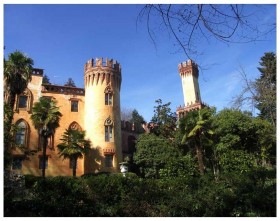
Surrounding the castle is a very large, peaceful and lush park, designed in a Romantic style that contains many paths, look out points and peaceful corners.
Tours are available and access many of the rooms in the main building before continuing to the monumental conservatory and then into the gardens.
Although the town of Busca is not on my “must see list” after touring the castle you are only 20mins from Saluzzo or else if you want to cool off in the Alps, one can head into the Upper Maira Valley where one can find woods and walking trails, a paradise for hikers and mountain bikers.
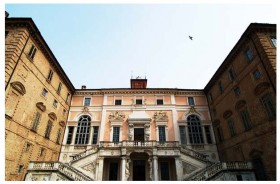 Castello Reale di Carlo Felice di Govone is located 30mins from Barolo in the hilltop town of Govone, which easily can be reached from the autostrada direction Asti.
Castello Reale di Carlo Felice di Govone is located 30mins from Barolo in the hilltop town of Govone, which easily can be reached from the autostrada direction Asti.
The castle is mentioned in a bill of sale from 989 when it was likely a very medieval structure typical of the Monferrato fortresses, but the current structure is the result from a major rebuilding effort carried out in the 13th century by the Solaro counts, including Count Giuseppe Roberto Solaro.
The castle exchange hands many time in the 1800’s to finally be acquired by the Ovazza Segre family who handed it over to the municipal government in 1897.
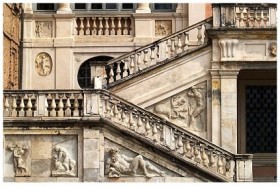 In 1997, UNESCO designated it a World Heritage Sites. A series of careful restoration works are returning the castle to its original splendour, within the splendid setting of its vast park.
In 1997, UNESCO designated it a World Heritage Sites. A series of careful restoration works are returning the castle to its original splendour, within the splendid setting of its vast park.
The castle is an imposing brick structure with a façade rich in decoration and sculptures. The whole building is bordered to the north and west by a vase English style garden and to the east bygarden of fountains, trees and flowerbeds.
Castello Reale di Racconigi is located 40min north of Barolo, exit the A6 direction Torino at Carmagnola. It is considered “a must see” of the royal Savoy residences.
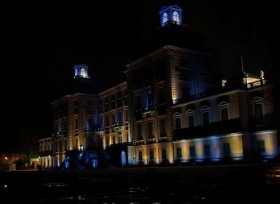 The castle was originally built as a mighty military fortress at the end of the 12th century/beginning of the 13th century by the marquises of Saluzzo. After exchanging hands many times, it was then in the 16th century the Savoys transformed it from a fortress into a residence by Prince Emanuele Filiberto Amedo, then heir to the throne of Savoy.
The castle was originally built as a mighty military fortress at the end of the 12th century/beginning of the 13th century by the marquises of Saluzzo. After exchanging hands many times, it was then in the 16th century the Savoys transformed it from a fortress into a residence by Prince Emanuele Filiberto Amedo, then heir to the throne of Savoy.
During the Jacobin revolts of the late 18th century the castle suffered occupation and the confiscation of goods by the French troops, but after a period disuse, it returned to the Savoy family, more specifically, Charles Albert who had the architect Palagi oversee the refurbishment and also was responsible for works on the park, which he designed in English neo-Gothic style.
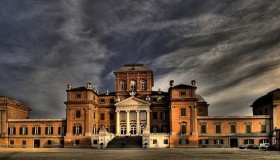 When the capital of Italy was moved from Turin to Rome, the castle was a favorite residence of the royal family and was used as a summer residence during the mid-1800s. The castle’s last owner was Umberto II, who received it from Victor Emanuel III as a wedding gift.
When the capital of Italy was moved from Turin to Rome, the castle was a favorite residence of the royal family and was used as a summer residence during the mid-1800s. The castle’s last owner was Umberto II, who received it from Victor Emanuel III as a wedding gift.
The castle is noteworthy for its majestic architecture as well as its varied interior which contain different periods and styles of woodwork, painting, stucco etc. It is admired for retaining the atmosphere of a house that documented the lifestyle of 19th and 20th century royal family.
The public can visit the first and second floors, the kitchens and the park.
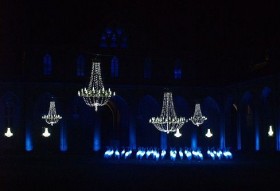 The castle is open from 9-18:30 Tuesday to Sunday. Tickets are €5. The park at the castle is open Tuesday to Sunday from 10-19 and tickets for access to the garden are €2.
The castle is open from 9-18:30 Tuesday to Sunday. Tickets are €5. The park at the castle is open Tuesday to Sunday from 10-19 and tickets for access to the garden are €2.
There is a cafeteria to enjoy refreshments.
These 3 are part of an initiative called Castelli Aperti (Open Castles) that open to the public from May until October 90 historical residences that otherwise would be hard to access as many are privately owned.
The Castello Del Roccolo di Busca is open April 5th – October 31st, though closed in August. Check this website below for opening hours but generally from 14:30 to 19:00. Entrance is €5.
Castles of Piemonte: here you can find many more beautiful pictures of our favourite castles in Piemonte.
CASTELLO DEL ROCCOLO DI BUSCA
Frazione San Quintino, 17
12022 Busca (CN)
Tel: +39 0171 618260
Email: zelda.beltramo@marcovaldo.it
CASTELLO REALE DI CARLO FELICE DI GOVONE
Piazza Roma, 1
12040 Govone (CN)
Tel: +39 0173 58103
Email: segreteria@comune.govone.cn.it
CASTELLO REALE DI RACCONIGI
Via Morosini, 3
12035 Racconigi (CN)
Tel: +39 0172 84005
Email: comunica@castellodiracconigi.org
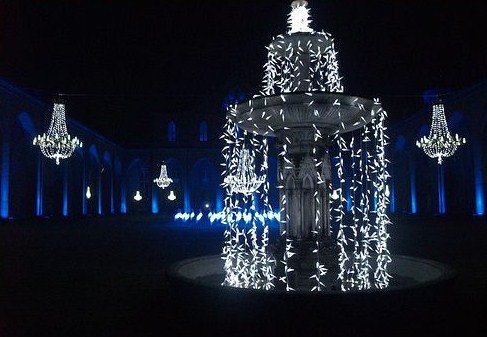
Tags: Busca, Carmagnola, Castello Reale di Carlo Felice di Govone, Castello Reale di Racconigi, Castello Roccolo di Busca, Castles of Piemonte, Cuneo Province, Govone, Langhe, Monferrato, Provincia di Cuneo, Racconigi, Saluzzo, Savoy, Savoy residence, Torino, TorreBarolo
Thu 1 Jul 2010
 Our wine guru Gary Chevsky, back in November 2009, experimented with some Barbera wines from Piemonte:
Our wine guru Gary Chevsky, back in November 2009, experimented with some Barbera wines from Piemonte:
“Unclear why anyone would want to drink aged Barbera, a wine grape that is associated with easy quaffing and everyday meals. In the land where Nebbiolo is firmly the king, why mess with that? Let Barbera and Dolcetto play their lowly part in the food chain. Affordable, refreshing, satisfyingly easy drinking table wines. What would the world do without them, no?
But of course someone is always ready to challenge status quo, try to make an eagle out of a sparrow, a Boeing out of a paper plane. Treat Dolcetto like a more serious grape, and you get Dolcetto di Dogliani, deeper, richer, more ageable. Treat Barbera like that, and what do you get?
On Monday, a small group of enthusiasts got together at a Ross Bott tasting in Los Altos to assess 1999-2001 Barberas by La Spinetta. La Spinetta has a “standard” or lower-end Ca’ Di Pian wine that costs in the teens, and a higher-end wine that costs $40-50. Having tasted Gaja’s 1995 Barbera “Sitorey” earlier this year and having found it a powerful, fresh, and nuanced wine, my expectations were mixed. After all, that was Gaja! Could anyone else approach that effort?
From the mailer by Ross Bott, the organizer:
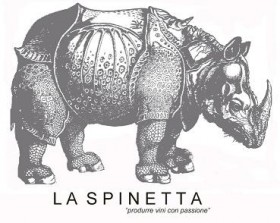
“Barbera is the third most planted red grape varietal planted in Italy, after Sangiovese and Montepulciano. Although planted in many of the northern Italian provinces, it is at its best in the Piedmonte region area around Asti, where it has DOCG status, Italy’s highest classification.
The varietal is naturally high in acid and low in tannins, and, when vinified in a lighter style to be drunk young, is a fine everyday wine to complement pastas and other northern Italian dishes. However, when yields are kept low and the grapes are harvested at riper levels, the resultant wines can be deep, complex and long aging, and marry particularly well with new medium toasted (or charred) oak barrels. Ironically, this approach is a relatively recent phenomenon in Piedmonte. In fact, some of the earliest examples of this approach were in the Shennandoah Valley in California, where Montevina made some great old Special Selection Barberas in the late 1970s — to my view the most exciting wines ever to come out of the Sierra Foothills.
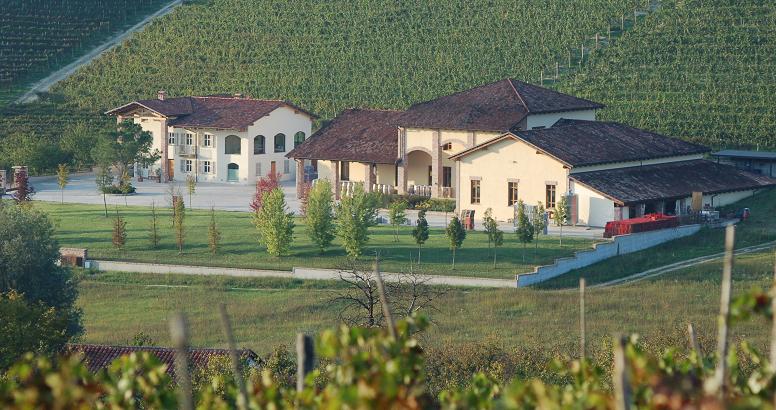
In 1998, Giuseppe Rivetti began to make a Barbera Superiore under his La Spinetta label, a serious, high-end approach involving old vines, low yields, and aging for 12-18 months in new French oak. Rivetti was born in Argentina, but his family was Piedmontese, and he returned in 1977 to the Asti region, in an area then known for Moscato d’Asti, a fragrant, low alcohol wine made from a varietal in the Muscat family. After producing some landmark examples of this white wine, he ventured into reds in 1985, first with Barbera and later adding Barbarescos and Barolos. He produces three Barberas a year, a Ca’ Di Pian which is richer and riper than most Barberas, but sees less oak, a Gallina from a single vineyard which also provides the grapes for his Barbaresco, and a Superiore, which is a reserve bottling from a selection of his best barrels. Both of the latter get extended barrel treatment and are among the three or four best Barberas produced anywhere.
Tonight, we’ll try six La Spinetta Barberas, a pair from each of 1999, 2000 and 2001. One member of each pair will be the lightly oaked Ca’ Di Pian and the other an example of his highest end Barberas which get extended treatment in new oak.”

From what La Spinetta I have tasted, it seems to have a ripe fruity style, perhaps closer to new world than old. On the photos below, the wines are ranked right to left in the order of scores. Easily in our blind tasting, the group ruled that more expensive wines beat out the cheaper ones. Though drinkable, the lower-end ones obviously not built for aging were slightly pickled, dusty, and funky. The higher-end “Superiore” and “Gallina” were in perfectly good shape, maintaining fresh fruit.
While the top 3 wines still “showed” young, it is as if they had artificially been beefed up to last longer, and the age did not give them subtlety, complexity, and secondary flavors that I’ve seen develop in properly aged ageworthy wines. It seemed rather pointless to me to spend $45 a bottle, then cellar it for 10 years, when in that range one finds some wonderful Nebbiolo and Sangiovese options. While obviously we confirmed Barbera’s ageability, I would not call that ageworthiness. It bothered me that the wines lacked finesse and complexity, and the question that firmly stuck in my mind was – “What’s the point!???”
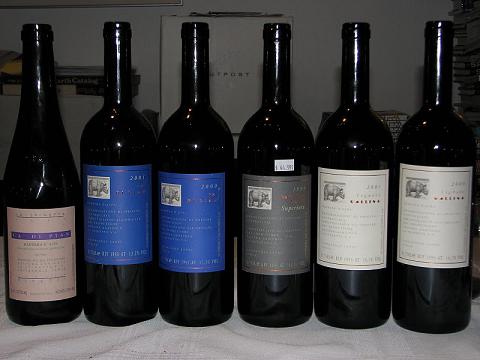
Thu 24 Jun 2010
One of my favourite places to go in the Langhe to enjoy a dramatic setting among the rolling hills is the Grinzane Castle in Grinzane Cavour, less than a 10minute drive from TorreBarolo.
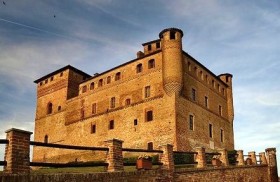 The castle is an imposing building erected around a central tower that dates back to the 1st half of the 11th century and post a restoration in 1960 it can be admired in all of its original beauty. Moreover, by being set off from the town and surrounded by vineyards on three sides, it has one of the most spectacular settings in the Langhe.
The castle is an imposing building erected around a central tower that dates back to the 1st half of the 11th century and post a restoration in 1960 it can be admired in all of its original beauty. Moreover, by being set off from the town and surrounded by vineyards on three sides, it has one of the most spectacular settings in the Langhe.
The castle currently is homes to numerous facilities. On the ground floor is the Piedmontese Regional Enoteca, which was the first to be set up in Piedmont back in 1971. This enoteca showcases the very best regional wines and grappas and each wine goes through a strict selection process before being displayed and placed on sale. The enoteca provides tastings as well.
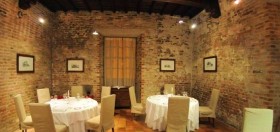 When my wine fanatic friends are visiting me at TorreBarolo, I always bring them here as from my experience it does have the best selection of the regional offerings and offering good one stop shopping. Here you can find a list of all the wineries represented in the Enoteca Regionale. On the 1st floor is the Hall of the Masks as well as a restaurant and bar. The Hall of the Masks is where the Order of the Knights of the Truffle and Wines of Alba as well as the National Association of Cheese tasters celebrates its Chapters. The Restaurant Al Castello offers a unique setting; however, it is the bar that I think is worth making a special stop for as it has a huge window that frames the surrounding vineyards that makes for a breath-taking venue to have a café or aperitif.
When my wine fanatic friends are visiting me at TorreBarolo, I always bring them here as from my experience it does have the best selection of the regional offerings and offering good one stop shopping. Here you can find a list of all the wineries represented in the Enoteca Regionale. On the 1st floor is the Hall of the Masks as well as a restaurant and bar. The Hall of the Masks is where the Order of the Knights of the Truffle and Wines of Alba as well as the National Association of Cheese tasters celebrates its Chapters. The Restaurant Al Castello offers a unique setting; however, it is the bar that I think is worth making a special stop for as it has a huge window that frames the surrounding vineyards that makes for a breath-taking venue to have a café or aperitif.
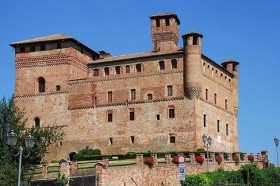 Several of the castle’s rooms are dedicated to ethnography and the castle houses a permanent museum which includes truffles, rare articles relating to local food and wine traditions as well as kitchen setting from the 17th century.
Several of the castle’s rooms are dedicated to ethnography and the castle houses a permanent museum which includes truffles, rare articles relating to local food and wine traditions as well as kitchen setting from the 17th century.
Every November the castle is home to the world famous White Truffle Auction where celebrated chefs from throughout Italy and the world attend to participate in the live worldwide auction for the finest Albese white truffles. It is not unusual for the most select truffles to go for over €100,000.
Opening hours are 09.30 – 19.00 (April to October) and 09.30 – 18.00 in the winter months. The castle is closed on Tuesdays.
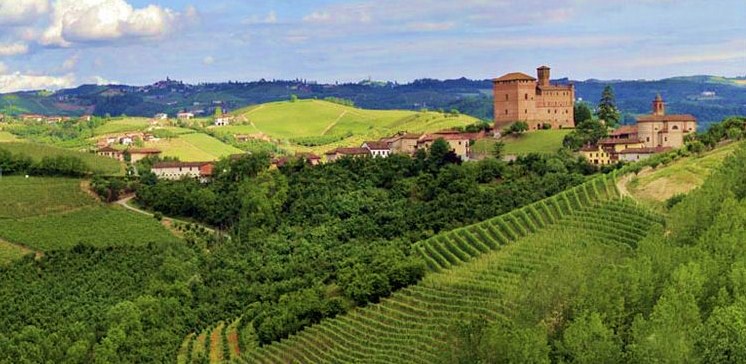
Thu 3 Jun 2010
Our friend Nancy Yos, of blog At First Glass, kindly shared with us her thoughts on a 2006 Vobis Tua Barbera d’Asti from Cantine Volpi. Nancy has been blogging for three years and her posts cover a wide range of wines and regions.
2006 Vobis Tua Barbera d’Asti
Producer: Cantine Volpi s.r.l., Tortona, Italy.
Light bodied, briny piquancy — tart, underripe raspberries – a little tarry or smoky — needs food
2nd day: mellowed and silkier 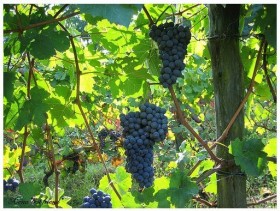
Barbera d’Asti is both a grape and a DOC (Denominazione di Origine Controllata) but note that smaller case b-barbera is the grape, while capital B-Barbera d’Asti refers to the DOC, in the lovely Piedmont region of northwest Italy, spelled in Italian Piemonte. If Italy generally conjures up images of sunshine, rolling hills, Rome, Renaissance art, and pasta, for Piedmont in particular we ought to think instead of mountains (the Alps), rushing rivers (the Po), drifting fogs, of industrial Turin, and oddly enough of rice and corn cultivation. Both are major crops here (think risotto and polenta).
For its part, our glass of Barbera d’Asti represents a sort of little brother in a hierarchy of Piedmont’s red wines, ranking below the great Barbaresco and the still greater Barolo, both named for their places of origin within Piedmont but vinified from the nebbiolo grape — which in turn is named, it seems, for the drifting fogs (nebbia). Barbera can be either Barbera d’Asti, as we have here, or Barbera d’Alba; the latter is considered just slightly more of a heavyweight than the former, which seems to be why Barbera d’Asti is an everyday what’s-for-dinner wine in this part of Italy. Barbera d’Alba is also another DOC.
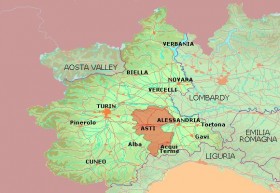 Like so many Italian red wines, except its powerhouse big brothers Barbaresco and Barolo, a Barbera has that tart, light, berry-like flavor and a texture that seems a little grainy and rough, as if a few seeds of a fresh raspberry had found their way into the bottle and added their own little interesting zip there.
Like so many Italian red wines, except its powerhouse big brothers Barbaresco and Barolo, a Barbera has that tart, light, berry-like flavor and a texture that seems a little grainy and rough, as if a few seeds of a fresh raspberry had found their way into the bottle and added their own little interesting zip there.
Wine books always emphasize that Italian wines like this, tending to be thin, fresh, and acidic, are meant to be drunk with a meal and not treated as a free-standing cocktail, which is often how we drink syrupy, barbecued-fruit California cabernets or merlots. Karen MacNeil in The Wine Bible writes rapturously of the Piedmontese food that would go with a Barbera, or even better, with its muscular big brothers, Barbaresco and Barolo: heavy meat dishes, thick risottos, eggy fresh-made pastas dressed only with butter and sage leaves or, if you are lucky and are visiting in the fall, with shavings of white truffle from Alba. The truffle’s spectacular taste, MacNeil explains in a sidebar, has been studied in science labs, and has been found to derive from some sort of chemical that is also present in the testes of men and bulls. Experienced people hunt for them at night in secret, with specially trained white dogs. Wasn’t there a commercial jingle that used to assure us Italians have more fun?
Indeed they seem to, and another of Italy’s most fun wines, Moscato d’Asti, is also a product of this same Piedmont that gives us our very serious Barolos and our zippy Barberas. Of this, I can provide just one quick tasting note: it’s flying off the shelves in grocery stores now, outperforming even queen Chardonnay and princess Pinot Grigio.
Vobis Tua, we are told, is Latin for “as you like it.” We like it. Retail: about $10-$12.

 But the museum is not focused on the history and details of making Barolo. It seems like the main goal is to get visitors involved and engaged, and less to inform them. There is little factual information here and visitors looking to get an in-depth knowledge of winemaking are likely to be disappointed.
But the museum is not focused on the history and details of making Barolo. It seems like the main goal is to get visitors involved and engaged, and less to inform them. There is little factual information here and visitors looking to get an in-depth knowledge of winemaking are likely to be disappointed.















 Like so many Italian red wines, except its powerhouse big brothers Barbaresco and Barolo, a Barbera has that tart, light, berry-like flavor and a texture that seems a little grainy and rough, as if a few seeds of a fresh raspberry had found their way into the bottle and added their own little interesting zip there.
Like so many Italian red wines, except its powerhouse big brothers Barbaresco and Barolo, a Barbera has that tart, light, berry-like flavor and a texture that seems a little grainy and rough, as if a few seeds of a fresh raspberry had found their way into the bottle and added their own little interesting zip there. 









